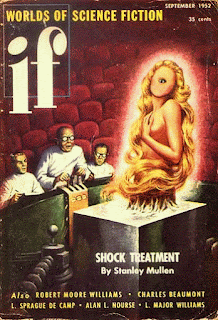 |
| cover art by Ralph Joiner |
Triplanetary
In some alternate universe, Venus, Earth and Mars all had stable ecosystems that allowed humanoid life forms to evolve. However, in this universe, as early as 1784, astronomers knew that the atmosphere of Mars was very thin and cold. This was confirmed by spectroscopy in the late 1800s.
 |
| retro-reading pulp on my desktop |
Astronomers discovered that Venus is the opposite of Mars. By the late 1700s it was known that Venus has a thick atmosphere. By the 1940s, it had been calculated that the surface of Venus must be extremely hot and smothered under a thick carbon dioxide atmosphere.
By 1952 everyone who cared about the science already knew that Mars and Venus were not likely to support advanced forms of life, but science fiction stories about civilizations (often extinct) on those worlds continued to be written. Many science fiction writers had long since given up on the pass-time of writing stories about life on Mars and Venus... they now set their stories about space aliens on imagined exoplanets of distant star systems.
Venus
 |
| On the run! No rain? Interior art by Wilson |
But first, Spud Newlin is tending bar on the bad $ide of the tracks of Venusport. Things are boring until Songeen walks in. Spud mutters to himself, "Of all the gin joints in all the towns in all the worlds, she walks into mine."
 |
| Willy Ley - April 1966 Galaxy magazine |
Nanites
 |
| see If, November 1952 |
As advanced as the culture of Mr. and Mrs. Songeen seems to be from the perspective of the poor stupefied Newlin, there are also the Masters, non-material creatures who advise lesser beings like Mrs. Songeen. The entire galaxy (under the stern guidance of the Masters) is ready to exterminate the human species since human scientists are madly at work... discovery of technology for interstellar space travel by humans is imminent. Nobody wants the diseased humans spreading through the galaxy.
 |
| Golly, Mr. Science! |
 |
| Odo from DS9 |
 |
| Positronics in 1941 |
Previously: "Reason" by Isaac Asimov (1941)
"Inheritance" by Arthur C. Clarke (1947)
Also, find a link here to an old (1950) Jack Vance story.
Asimov (again) Nightfall in 1941.
The Lani People by J.F. Bone (1962)
Arthur C. Clarke's Against the Fall of Night (1948)
also: some Sci Fi from 20,000 B.C.E.
Astounding 1932
 |
| Project Gutenberg |
Related Reading: Project Gutenberg Science Fiction Bookshelf.
Next: evolving a better human (1937)
Future: 2018 Retro-Reading
 |
| Retrofuture: some detail from Tomáš Müller's Technicall magazine cover (Jan. 2010). |
 |
| visit the Gallery of Book and Magazine Covers |

No comments:
Post a Comment